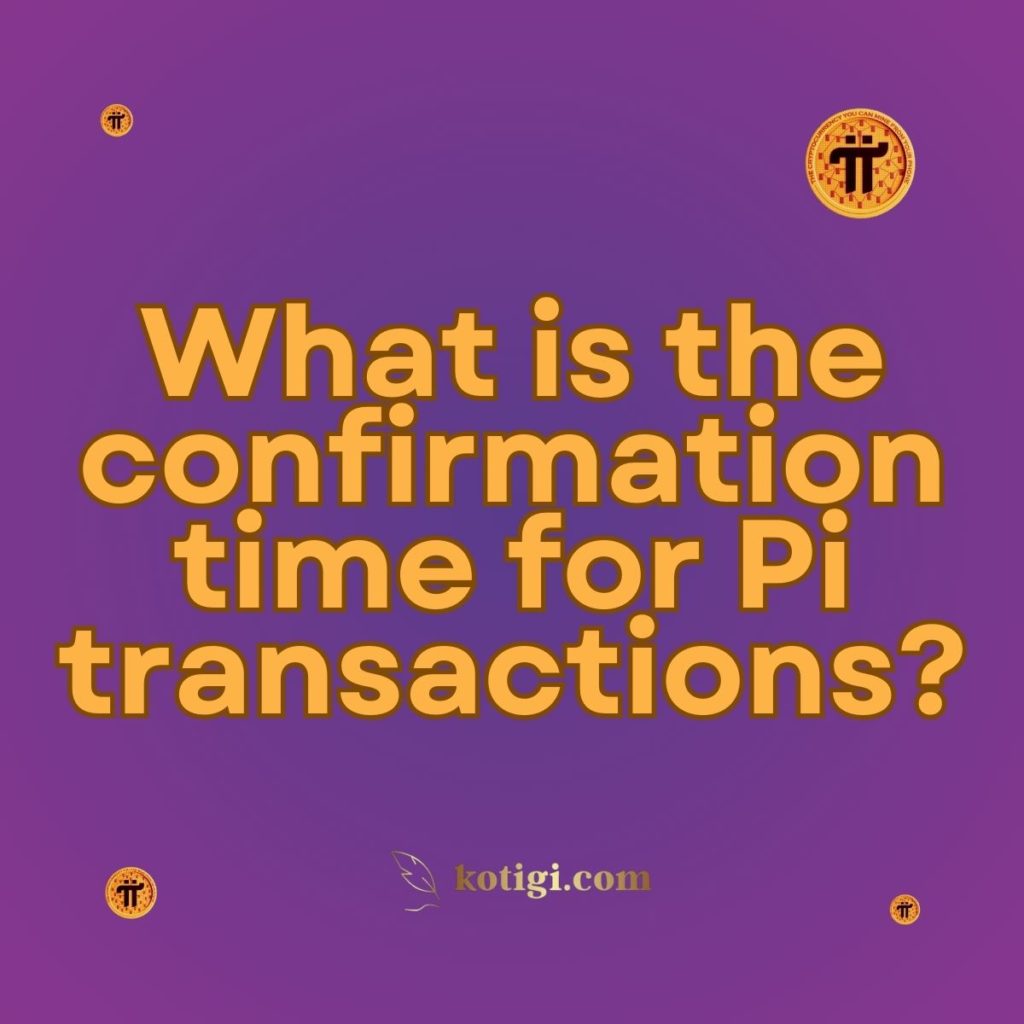
What is the confirmation time for Pi transactions?
The confirmation time for Pi transactions varies depending on network activity. On average, Pi transactions are completed within a few seconds to a few minutes due to the efficient Stellar Consensus Protocol (SCP) that Pi Network uses. However, during periods of high traffic, minor delays may occur.
Introduction
As cryptocurrency becomes increasingly mainstream, the speed at which transactions are processed is a key factor in determining the usability of a network. In the Pi Network, transaction confirmation time refers to the period it takes for a transaction to be validated and added to the blockchain. By using a consensus mechanism called the Stellar Consensus Protocol (SCP), Pi Network achieves efficient transaction confirmation. This post will explore how long Pi transactions take, what factors affect them, and how the confirmation times compare to other cryptocurrencies.
Table of Pi Network’s transaction confirmation time in relation to other cryptocurrencies
Here’s a comparison table highlighting Pi Network’s transaction confirmation time in relation to other popular cryptocurrencies like Bitcoin, Ethereum, and Litecoin. This table helps users understand how Pi stacks up against these other cryptocurrencies in terms of transaction speed, consensus mechanism, and other key factors.
| Cryptocurrency | Transaction Confirmation Time | Consensus Mechanism | Energy Consumption | Transaction Fees | Scalability |
|---|---|---|---|---|---|
| Pi Network | Seconds to minutes | Stellar Consensus Protocol (SCP) | Low (mobile-friendly) | None | High (designed for scale) |
| Bitcoin | 10 minutes to several hours | Proof of Work (PoW) | Very High | High | Limited (scalability challenges) |
| Ethereum (Pre-2.0) | 15 seconds to several minutes | Proof of Work (PoW) | High | Moderate to high | Moderate (improving with Ethereum 2.0) |
| Ethereum 2.0 | 12 seconds to minutes | Proof of Stake (PoS) | Low | Moderate | High (improved scalability with sharding) |
| Litecoin | 2.5 minutes | Proof of Work (PoW) | High | Low | Moderate |
| Ripple (XRP) | 4-5 seconds | Ripple Protocol Consensus Algorithm | Low | Very Low | High (efficient for cross-border payments) |
| Cardano (ADA) | 10 minutes to 15 minutes | Proof of Stake (PoS) | Low | Low | High |
| Stellar (XLM) | 3-5 seconds | Stellar Consensus Protocol (SCP) | Low | Very Low | High |
Key Points of Comparison:
- Transaction Speed: Pi Network’s transaction speed is competitive, taking seconds to a few minutes for confirmations. It is faster than Bitcoin and comparable to Ripple (XRP) and Stellar (XLM).
- Consensus Mechanism: Pi Network and Stellar use the Stellar Consensus Protocol (SCP), allowing for faster transactions and lower energy consumption. Meanwhile, Bitcoin and Litecoin still rely on Proof of Work (PoW), which is slower and more energy-intensive. Ethereum 2.0 and Cardano leverage Proof of Stake (PoS), which is more scalable and energy-efficient.
- Energy Consumption: Pi Network stands out with minimal energy consumption, especially compared to traditional PoW systems like Bitcoin and Ethereum (pre-2.0).
- Transaction Fees: Pi Network currently charges no transaction fees, unlike Bitcoin and Ethereum, which can have relatively high fees during peak network usage.
- Scalability: Pi Network, along with Stellar and Ripple, is designed to handle large volumes of transactions efficiently, whereas Bitcoin struggles with scalability due to its slower transaction speeds and PoW consensus.
This comparison demonstrates how Pi Network is positioned as a mobile-friendly and energy-efficient alternative to traditional cryptocurrencies, with competitive transaction speeds and scalability advantages.
Pi Network’s Blockchain and Transaction Confirmation
Understanding Pi’s blockchain technology is crucial to grasp how confirmation times work. This section covers how Pi’s blockchain operates and how transactions are confirmed.
What is the Pi Network?
Pi Network is a revolutionary cryptocurrency project that allows users to mine Pi coins using their mobile phones without draining their battery or energy resources. Unlike traditional crypto mining, Pi operates on a lightweight model designed for accessibility.
How Does Pi Network’s Blockchain Work?
Pi Network’s blockchain is a decentralized ledger where all Pi transactions are recorded. Whenever a user sends Pi to another user, the transaction needs to be confirmed by the network, ensuring its validity before it is added to the blockchain.
Why is Transaction Confirmation Important?
Transaction confirmation prevents issues like double-spending, where a user could try to spend the same cryptocurrency twice. Without confirmation, the blockchain cannot maintain its security and integrity.
How Does Pi Network Differ from Other Blockchains?
Unlike Bitcoin or Ethereum, which require resource-heavy mining to confirm transactions, Pi Network’s blockchain relies on a more energy-efficient method called the Stellar Consensus Protocol (SCP), allowing for faster and more accessible transactions.
How Secure is Pi’s Blockchain?
Pi’s blockchain uses a decentralized system of trusted nodes, ensuring that each transaction is verified by multiple participants. This enhances the security of the network while keeping confirmation times short.
Does Pi Network Use Proof-of-Work?
No, Pi Network does not rely on Proof-of-Work (PoW) like Bitcoin. Instead, it uses a consensus algorithm that leverages trusted nodes within a user’s Security Circle to confirm transactions.
Stellar Consensus Protocol and Its Impact on Pi Transaction Time
The Stellar Consensus Protocol (SCP) is central to how Pi Network confirms transactions. Let’s explore SCP and how it accelerates Pi transaction times.
What is Stellar Consensus Protocol (SCP)?
SCP is a consensus mechanism originally developed by the Stellar blockchain. It allows for rapid agreement between nodes on which transactions should be confirmed, making it highly efficient compared to older consensus models.
How Does SCP Speed Up Pi Transactions?
SCP works by creating quorum slices, or groups of trusted nodes, that quickly validate transactions without the need for energy-consuming computations. This reduces transaction times significantly compared to Proof-of-Work systems.
What is a Quorum Slice?
A quorum slice is a subgroup of nodes in the network that agrees on which transactions are valid. In Pi Network, your Security Circle functions similarly to a quorum slice, validating transactions from trusted users.
Why is SCP More Efficient Than PoW?
Unlike PoW, which requires solving complex puzzles to confirm transactions, SCP relies on a decentralized trust system that allows participants to reach consensus faster. This leads to quicker transaction confirmations.
What Role Do Security Circles Play?
In Pi Network, Security Circles are groups of trusted users who validate transactions within the SCP framework. The more active and responsive the members of your Security Circle, the quicker your transactions are confirmed.
Is SCP Scalable?
Yes, SCP is designed to scale effectively as more users join the network. This ensures that even as Pi Network grows, transaction times remain fast and efficient.
How Does SCP Improve Network Security?
SCP enhances security by relying on trusted participants to validate transactions, reducing the chances of malicious activity. This decentralized approach ensures that no single node has excessive control over transaction confirmations.
Average Pi Transaction Confirmation Time
Now that we understand the technology behind Pi’s confirmation process, let’s examine how long it typically takes for Pi transactions to be confirmed.
How Long Does a Pi Transaction Take?
Pi transactions are generally confirmed within a few seconds to a few minutes. This fast confirmation time is one of the key advantages of Pi Network, making it more user-friendly compared to other cryptocurrencies.
What Factors Affect Pi Transaction Speed?
Several factors can influence how quickly a Pi transaction is confirmed, including network traffic, node activity, and the size of the transaction. Let’s break these down further.
How Does Network Traffic Impact Transaction Time?
During periods of high activity, such as when Pi announces new developments or events, the network may experience a higher volume of transactions. This can cause slight delays in confirmation times.
What Role Do Nodes Play in Confirmation Time?
Nodes within your Security Circle are responsible for verifying transactions. If these nodes are inactive or slow to respond, it could lead to delays in confirming transactions.
Do Large Transactions Take Longer to Confirm?
In general, larger transactions do not take significantly longer to confirm. However, if the transaction involves multiple parties or complex computations, it could take slightly more time.
How Does Pi’s Confirmation Time Compare to Bitcoin?
Bitcoin transactions can take 10 minutes to several hours to confirm due to the resource-heavy PoW system. Pi transactions, in contrast, are confirmed much faster due to the SCP, usually taking just seconds to minutes.
Is Pi Faster Than Ethereum?
Yes, Pi transactions are typically faster than Ethereum’s, which can take 15 seconds to several minutes depending on network congestion. Pi’s SCP allows for quicker consensus and confirmation times.
Can Pi Network Handle High Volumes of Transactions?
Pi Network’s SCP is designed to handle a high volume of transactions without compromising speed. As the network grows, Pi’s development team continues to optimize its performance to ensure rapid transaction confirmations.
Tracking Your Pi Transaction Confirmation
Pi Network provides users with tools to track their transactions in real-time, ensuring transparency and user confidence.
How Do I Track My Pi Transactions?
To track a transaction, simply open the Pi app, navigate to the wallet section, and view your transaction history. Here, you can see all past and pending transactions along with their confirmation status.
What Does “Pending” Mean in Pi Transactions?
A “pending” status indicates that the transaction has been initiated but has not yet been fully confirmed by the network. Most pending transactions are confirmed within a few minutes.
How Long Should I Wait for Confirmation?
In most cases, Pi transactions confirm within a few minutes. However, if network traffic is high or your Security Circle nodes are slow, it may take longer. Typically, users should wait no more than 10 minutes for confirmation.
What If My Transaction is Stuck?
If a transaction remains stuck in a pending state for an extended period, it may be due to network issues or node inactivity. You can try re-initiating the transaction or contact Pi Network’s support for help.
Are There Any Fees for Pi Transactions?
Currently, Pi transactions do not involve any fees, making the process not only fast but also cost-effective for users. This lack of fees contributes to the user-friendly nature of the Pi Network.
Can I Cancel a Pi Transaction?
Once a Pi transaction has been initiated and is in the confirmation process, it cannot be canceled. The decentralized nature of blockchain ensures that all confirmed transactions are permanent.
Will Pi Transaction Times Improve Over Time?
As Pi Network continues to grow and evolve, the development team is focused on improving transaction times. Future updates may introduce optimizations to further enhance speed and efficiency.
What Causes Delays in Pi Transaction Confirmations?
While Pi transactions are generally fast, occasional delays can occur. Here’s a look at some of the reasons behind these delays.
How Does High Traffic Cause Delays?
During times of high user activity, such as network-wide events or mass Pi distributions, the volume of transactions may temporarily slow down the confirmation process.
What Happens When Nodes Are Inactive?
If members of your Security Circle are inactive or not participating in the network, it can delay transaction confirmations. Having a highly active Security Circle ensures faster validation times.
Can Network Maintenance Affect Transaction Speed?
Pi Network occasionally performs maintenance or updates, which may temporarily slow down transactions. These updates are necessary to improve network performance and security.
What Can I Do if My Transaction is Delayed?
If you experience a delay, check Pi Network’s official announcements to see if there are any known issues. Additionally, ensure that your Security Circle is active and functioning properly.
Are Delays Common on Pi Network?
Delays are relatively rare on Pi Network, especially compared to older cryptocurrencies like Bitcoin. However, like any decentralized network, occasional slowdowns may occur during periods of high traffic or maintenance.
How Can I Avoid Transaction Delays?
To minimize the chances of a delay, ensure that your Security Circle consists of active and responsive members. Also, try to avoid making transactions during periods of known network congestion.
Does the Development Team Address Transaction Delays?
Yes, Pi Network’s development team is constantly working to improve the system and address any potential issues that may cause transaction delays. They regularly release updates to optimize transaction speed and performance.
Conclusion
Pi Network offers users fast transaction confirmation times, usually within seconds to minutes, thanks to the Stellar Consensus Protocol. While occasional delays can occur due to network congestion or inactive nodes, Pi transactions are generally much faster than those of traditional cryptocurrencies like Bitcoin and Ethereum. As the network grows, Pi is expected to maintain or even improve its transaction speeds, making it a user-friendly and efficient cryptocurrency for everyday use.
Key Takeaways:
- Pi transactions are typically confirmed within seconds to minutes.
- The Stellar Consensus Protocol enables faster transactions compared to traditional cryptocurrencies.
- Network traffic, node activity, and other factors can occasionally cause delays.
- Pi’s transaction times are faster than Bitcoin’s and on par with Ethereum’s.
- Pi Network continues to optimize its system for faster, more reliable transactions.





